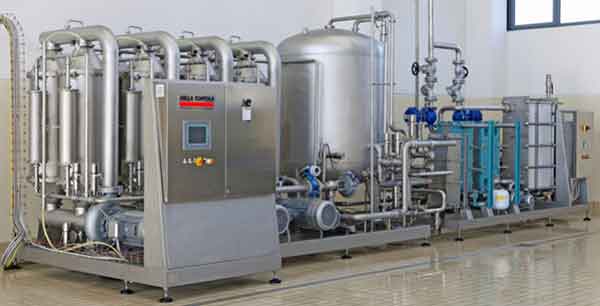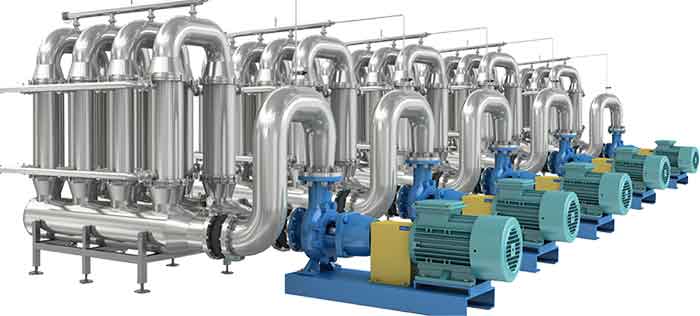Nội dung
CÔNG NGHỆ MÀNG LỌC CERAMIC

Nhà sản xuất: ATECH - Đức
Công nghệ màng lọc Ceramic vận hành đơn giản, không cần kỹ sư có trình độ cao, dễ dàng bảo trì, yêu cầu xử lý sơ bộ đơn giản, quý trình vận hành ổn định. Ưu điểm màng lọc Ceramic so với màng polymer hữu cơ là độ bền cơ học cao, tuổi thọ màng có thể lên tới 10 năm.
Ceramic materials are generally very stable chemically, thermally and mechanically, and in addition are frequently bio inert. They are therefore ideal materials for many applications in the chemical and pharmaceutical industry or in water and wastewater processing.
The medium to be filtered flows through the channels of the membrane carrier. Particles are retained if their size exceeds the radius of the membranes pores, building up the concentrate. The filtrate permeates through the pores and it is subjected to subsequent process stages
Vật liệu gốm nói chung là rất ổn định về mặt hóa học, nhiệt và cơ học, và thêm vào đó là thường xuyên trơ sinh học. Do đó, chúng là vật liệu lý tưởng cho nhiều ứng dụng trong các ngành công nghiệp hóa chất và dược phẩm hoặc trong xử lý nước và nước thải.Các phương tiện để được lọc chảy qua các kênh của các nhà cung cấp dịch màng. Các hạt được giữ lại nếu kích thước của họ vượt quá bán kính của các lỗ chân lông màng, xây dựng tập trung. Dịch lọc thấm qua các lỗ chân lông và nó là đối tượng của các giai đoạn quy trình tiếp theo

Many are the advantages deriving from the ceramic membrane use: they separate mixtures physically. They are ecologically friendly and more favourable than other separation technologies. No additives are necessary and the process temperature is not limited.
Filtration with ceramics is a mild, highly selective process without phase transformation. Running costs are limited by closed production cycles and continuous processes.
Ceramic membranes offer:
-
chemical, mechanical and thermal stability;
-
ability of steam sterilisation and back flushing;
-
high abrasion resistance;
-
high fluxes;
-
high durability;
-
bacteria resistance;
-
possibility of regeneration;
-
dry storage after cleaning.
Disadvantages are their high weight and the considerable production costs of ceramic components. However, the latter are generally compensated for by a long service life.
The supports for the membrane elements are made from a-aluminium oxide or silicon carbide with open pores. This material can provide not only maximum permeability but can also fulfill high requirements relating to mechanical stability. These supports are either for a single channel or a multi-channel design. A membrane layer of a define texture only a few mm thick is applied to the inner side of the channels in a sandwich-type process and connected monolithically.

Applications
Ceramic membranes are increasingly being used in a broad range of industries such as biotechnology and pharmaceutical, dairy, food and beverage, as well as chemical and petrochemical, microelectronics, metal finishing, and power generation. Each industry presents specific needs and opportunities.
The membrane modules can withstand elevated temperatures, extremes of pH (0 to 14), and high operating pressures up to 10 bar (145 psi) without concern for membrane compaction, delamination or swelling. This makes these membranes suitable for many applications where polymeric and other inorganic membranes cannot be used.
Additionally, ceramic membranes are ideal for in-place chemical cleaning at high temperatures, while using caustic, chlorine, hydrogen peroxide, ozone and strong inorganic acids, and/or by using steam sterilization.
Industrial applications
Clarification of natural fruit juices such as apple, cranberry and grape is one of the most successful and widely practiced industrial applications of ceramic membranes.
In the filtrations of sugar cane juice ceramic membranes can be used in several different stages in the raw and refine sugar production. the need to purchase, use and dispose of filter aids is then eliminated.
Ceramic membranes are used for fermentation broth clarification at numerous installations worldwide, successfully competing with other technologies such as polymeric membranes, vacuum filtration and centrifugation.
Finally, in many chemical process application there is the need to treat not only the waste streams, but also to recover and reuse chemicals. Ceramic membranes can be applied for this purpose, i.e. filtration of chemical solvents, dye and pigment wastewater from dye processing and colouring plants and highly variable wastewater containing detergents, polymers and organic solvents.
Initially, ceramic membranes were used in wastewater technology. Meanwhile, successful solutions and possible applications cover all industries where media were filtered.
-
Chemical industry:
- product separation and cleaning
- concentration of polymer suspensions and metal hydroxide solutions
- separation of catalysts
- recovery of dyes and pigments
- desalination of products
- cleaning and recycling of organic solvents -
Metal industry / Surface engineering:
- recycling and disposal of degreasing and rinsing bathes
- treatment of oil/water emulsions
- recovery of heavy metals
- cleaning of wastewater from grinding processes
- treatment of wastewater form glass and glass fibre production -
Textiles / Pulp and paper industry:
- concentration, fractionation, isolation and sterilization for antibiotics, enzymes, proteins, amino acids and vitamins
- separation, concentration and dewatering of biomass and algae
- disposal of fat emulsions
- separation of yeast
- desalination -
Food and beverages
- clarification of juice and beer
- concentration of juice
- sterilization of milk and whey
- separation and fractionation of milk and whey ingredients
- desalination of whey
- dewatering of products
- purification of drinking water -
Recycling and environment
- COD/BOD reduction
- oil/water separation
- recovery of pharmaceuticals and pesticides
- retention of microorganinsm
- retention of heavy metals and radioactive substances
- recycling of water form swimming pools
- purification of the drain of sewage plants.
